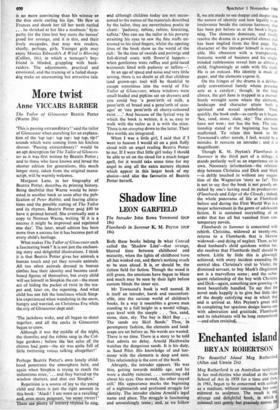More twist
Anne VICCARS BARBER
The Tailor of Gloucester Beatrix Potter (Warne 20s) 'This is passing extraordinary!' said the tailor of Gloucester when searching for an explana- tion of the lap tap : tap tap : tap tap, tip !' sounds which were coming from his kitchen dresser. 'Passing extraordinary!' would be an apt description for The Tailor of Glouces- ter as it was first written by Beatrix Potter ; and to those who have known and loved the shorter edition for generations, this much longer story, taken from the original manu- script, will be warmly welcome.
Margaret Lane, in her biography of Beatrix Potter, describes its printing history. Being doubtful that Warne would be inter- ested in another book so soon after the pub- lication of Peter Rabbit, and fearing altera- tions and the possible cutting of The Tailor and its rhymes, Beatrix Potter paid i40 to have it printed herself. She eventually sent a copy to Norman Warne, writing 'If it is a success it might be improved and reprinted one day'. The later, small edition has been more than a success for it has become part of every child's heritage.
What makes The Tailor of Gloucester such a fascinating book? It is not just the enchant- ing story and delightful illustrations. I think it is that Beatrix 'Potter gives her animals a human touch and yet they remain animals. All too often animals dressed in human clothes lose their identity and become card- board figures of themselves, but every child will see himself in Simpkin the cat—the mean act of hiding the packet of twist in the tea- pot and, later on, the repenting. And what child has not felt the loneliness which Simp- kin experienced when wandering in the snow, hungry and worried, on Christmas Eve while the city of Gloucester slept and:
'The jackdaws woke, and all began to shout together, and all the cocks in Gloucester began to crow.
Although it was the middle of the night, the throstles and the robins sang in the Col- lege gardens ; before the last echo of the chimes had gone—the air was quite full of little twittering voices talking altogether!'
Perhaps Beatrix Potter's own lonely child- hood penetrates the atmosphere here, and again when Simpkin is trying to reach the industrious mice, and they barred up the window shutters, and shut out Simpkin.'
Repetition is a source of joy to the young child and there is just the right amount in this book : 'Alack ! I am worn to a ravelling' and, even more poignant, 'NO MORE TWIST!' There are plenty of nutter thymea to sing,
and although children today are not accus- tomed to the names of the materials described by the tailor, they are nevertheless poetic to chant : 'padusoy, tobine, robins, lutestring, taffeta.' One can see the tailor in his poverty straining his eyes to sew the fine stuffs en- trusted to his tired fingers, whilst the opening lines of the book show us the world of the rich : 'In the time of swords and periwigs and full-skirted coats with flower'd lappets— when gentlemen wore ruffles and gold-laced waistcoats lined with padusoy or taffeta—'.
In an age of speed and noise and very little sewing, there is no doubt at all that children (and grown-ups too) will be thankful to escape sometimes into the world of The Tailor of Gloucester, where windows were small-leaded and pipkins sat on dressers and you could buy 'a penn'orth of milk, a penn'orth of bread and a penn'orth of saus- ages' or 'one penn'orth of cherry-coloured twist ...' And because of the lyrical way in which the book is written, it is as easy to walk with the tailor as it is with the mice. There is no stooping down to the latter. Their two worlds are integrated.
When I was a little girl, I said that if I went to heaven I would sit on a pink fluffy cloud with an angel reading Beatrix Potter to me. If I were that little girl today I should be able to sit on the cloud for a much longer spell, for it would take some time for my angel to sing all the extra nursery rhymes which appear in this larger book of my choice—and also the favourite of Beatrix Potter herself.














































 Previous page
Previous page